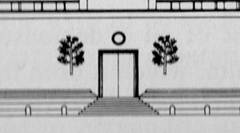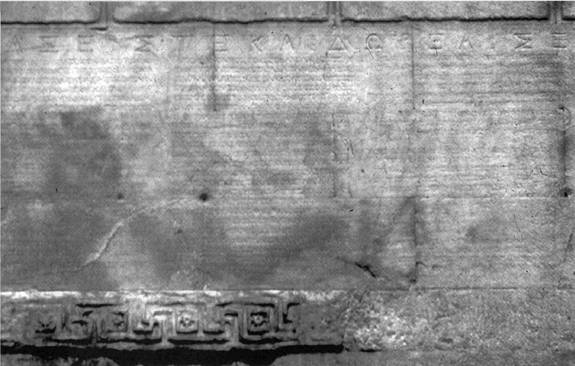
Architectural Elements and Symbolism:
The Statue:

(Zanker)
To a person approaching the Mausoleum, the first and most obvious image would have been an enormous gilded, bronze statue of Augustus on top of the tumulus. There is evidence that the statue was 8 or more meters in height, which added to that of the already impressive main structure (Zanker 76). The placement of such a colossal statue so far above ground level would have been almost unprecedented in Roman funerary practice (Rehak 41). Indeed, images of such scale were typically only used for divinities (Rehak 41).
Very little is known of the actual form of the statue, since nothing of it remains today. Several reconstructions have been proposed, but there is scant concrete evidence to support any theory or another. These range from a nearly nude Augustus, spear in hand (another symbol of military prowess) to a veiled image in a toga (a symbol of conservative social values) (Rehak 42). Regardless, whatever the precise form, it is almost certain that the statue would have portrayed Augustus as he most wanted to be remembered.
Entrance Obelisks:

(Zanker)
As one approached, more evidences of Augustus¡¯ achievements would have become visible. A pair of red-granite obelisks flanking the entrance referenced his successes in Egypt against Antony and Cleopatra at the Battle of Actium (Rehak 39). Even beyond Augustus¡¯ personal success, these stone pillars were a stark reminder that Rome had achieved dominance over Egypt.
Laurel Trees:

(Zanker)
As time progressed and Augustus¡¯ position became more secure and success were won, the decorations on the Mausoleum changed to reflect these new developments. One example was the pair of laurel trees carved into the stone around the entrance. Symbolically, these trees are closely associated with the senate¡¯s granting of the title ¡°Augustus¡± in 27 BC. These stone trees paralleled those planted by Augustus outside his home on the Palantine Hill after he received the acclamation (Rehak 39).
Shields:

(Zanker)
Surviving architectural fragments indicate that one or more round shields were carved into the decorative frieze of the Mausoleum. In keeping with Hellenistic custom, these shields were intended as a symbol of the formidable military prowess and heroism of the man entombed within (Rehak 40).
Tablets and the Res Gestae Divi Augusti:

(Res Gestae inscription in Ankara, From Rehak)
Perhaps the most explicit of the messages on the Mausoleum would have been prominently displayed text of the Res Gestae Divi Augusti (The Achievements of the Divine Augustus). According to literary sources, the text was carved either onto large tablets or piers that were either affixed to the front of the Mausoleum or onto the two obelisks that flanked the entrance (Rehak 55).
This self-produced catalogue of achievements allowed Augustus to articulate in his own words what could not clearly be conveyed through architectural symbolism. It has been suggested that his intent was to unambiguously pass on the aspects of his life that he thought would be most important to the future stability and ambitions of Rome. And by inscribing his words into bronze, Augustus attempted to ¡°guarantee the perpetuity¡± of his monumental message (Pliny, in Rehak 55). To some extent, the Res Gestae is an extension of the Roman tradition of funeral oratory; only in this case, Augustus found a way to deliver his own eulogy from beyond the grave.
